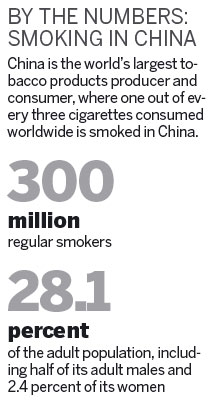No indoor nails for fewer coffins
By Liu Zhihua and Wang Quan ( China Daily ) Updated: 2014-12-27 09:21:48
Banning smoking in public places will help reduce tobacco-related deaths and illnesses.
Xu Guihua, the executive deputy director of the Chinese Association on Tobacco Control, said she was very happy when the State Council published the draft of a national law to control tobacco use.
On Nov 24, the State Council's legislative affairs office officially publicized the draft of a law that bans the smoking of tobacco products in indoor public areas and restricts smoking in outdoor public spaces to designated smoking areas.
|
Pupils at an elementary school in Hefei, Anhui province encourage community residents to quit smoking as soon as possible. Fu Jun / For China Daily |
The draft also prohibits all forms of tobacco advertising, promotion and sponsorship, as well as certain smoking scenes in films and TV shows.
And for the first time, it requires graphic health warnings to cover half of every Chinese packet of tobacco.
In the same week, Beijing authorities also passed a new law, making all indoor public places in Beijing 100 percent smoke-free from June 1, 2015.
Xu said that studies have shown that since 1999, the negative impacts of the industry on Chinese society, including medical treatment costs, have surpassed the tobacco industry's economic benefits, and it is important to control tobacco use through strong legislation and strict enforcement.
The country's lack of strong laws and poor enforcement of laws that do exist, as well as the lack of graphic health warnings, and controls on advertisements and sponsorship are the main reasons why China lags behind much of the world in tobacco control, Xu said.
"If the draft national regulation is adopted, this will represent unprecedented progress towards China meeting its obligations under the World Health Organization Framework Convention on Tobacco Control, and most importantly dramatic progress toward reducing the epidemic of tobacco-related illness and preventable death in China", said Bernhard Schwartlander, WHO representative in China, in a press release.
No 1 for tobacco use
As the world's largest tobacco products producer and consumer, one out of every three cigarettes consumed worldwide is smoked in China.
In total, the country has more than 300 million regular smokers, about 28.1 percent of the adult population, including half of its adult males and 2.4 percent of its women, according to the 2010 Global Adult Tobacco Survey report released by World Health Organization.
As a result, about 1 million people die every year because of tobacco use, around one in six of all such deaths worldwide.
And more than 700 million people are routinely exposed to second-hand smoke, which causes approximately 100,000 deaths every year.
That means that every 30 seconds a person dies in China because of tobacco use, around 3,000 people every day.
If tobacco use in the country is not curtailed, China's death toll will rise to 3 million a year by 2050, according to WHO.

Even though China became a signatory to the WHO Framework Convention on Tobacco Control as early as 2003, which meant it was required to ban smoking in public areas, reduce tobacco supplies and consumption, and prohibit all tobacco advertising, promotion and sponsorship when it became effective in 2006, the draft law now being considered is the first such national legislation in China. Moreover, there is no provincial law on tobacco control in most provinces in China, except in two municipalities - Beijing and Shanghai.
At the city level, among hundreds of cities, only 10 have related laws, such as Shenzhen in Guangdong province, and Lanzhou in Gansu province, according to Xu.
That is to say, only about 10 percent of Chinese people live in areas that have tobacco-control laws, Xu said.
The country's efforts to control tobacco use have been hampered by a number of obstacles, including the public's low awareness of the risks of tobacco use and the dangers of exposure to second-hand smoking.
"People may have a vague impression that smoking is bad for their health, but most people have no idea of how bad it can be," says Jiang Yuan, head of the Chinese Center for Disease Control and Prevention's tobacco control office, adding tobacco use and exposure to second-hand smoke are significant preventable risk factors to many illnesses, including heart disease, strokes, chronic obstructive pulmonary disease and cancer.
Studies show that half of all regular smokers will die prematurely because of tobacco use. In the United States and Europe, more than 80 percent of people know smoking and second-hand smoking cause diseases, but only 23.2 percent of Chinese adults believe smoking can lead to strokes, heart attacks and lung cancer. Only 24.6 percent of adults believe exposure to second-hand smoke causes heart disease and lung cancer in adults.
In rural areas, health awareness is even lower, Jiang added.
Wang Xiaohong, a respiratory-disease specialist with Peking University Third Hospital, said she is astonished that in hospitals, a lot of the medical staff smoke, ignoring all that they've learned in medical schools.
"Even if people know about the health risks, many consider that they are something far away in the future, and so should not prevent them from enjoying the habit now," says Wang, who also works as a stop-smoking therapist in the prestigious hospital.
Starting young
About 52.7 percent of Chinese smokers aged 20 to 34 started their daily habit before the age of 20, according to WHO figures.
Zhang Longfei, a 27-year-old Beijing resident, is a heavy smoker. He smokes about 30 cigarettes a day.
Zhang picked up the habit during college years, influenced by the students around him.
He has attempted to quit smoking several times, and failed.
"It is difficult to quit smoking when all people around you smoke," Zhang says.
"You cannot become integrated into the circles of people you want to get close with if you don't smoke or drink with them."
However, he says, deep in his heart he knows the real reason he failed was he was not determined enough.
"I didn't try hard enough," he says.
The findings of the 2014 China Youth Tobacco Survey, which was released by the Chinese Center for Disease Control and Prevention in May, found that among students aged 13 to 15 in 1,020 schools in 31 provinces, 9.4 million have smoked.
And about 11.2 percent of boys, 2.2 percent of girls, and 6.9 percent overall currently use tobacco.
Zheng Xinye, an economics professor with the School of Economics at Renmin University of China, says that the China National Tobacco Corporation, a State-owned company with a virtual monopoly over tobacco products, is able to manipulate the prices and sell low-priced tobacco products to teenagers and young people even though they have low purchasing ability.
Once they get addicted, they will be willing to spend large sums of money on tobacco products later in life, when they are able to pay, Zheng said.
Heavy taxation, which leads to high tobacco product retail price, is recommended by the WHO as one of the most effective measures for reducing tobacco consumption. However, for the most popular brands in China the taxation is around 40 percent, much lower than WHO's recommended minimum of 70 percent.
liuzhihua@chinadaily.com.cn
|
School students in Lianyuan, Hunan province advocate non-smoking lifestyle. The characters read 'refuse smoking, cherish life'. Zhang Yang / For China Daily |
(China Daily 12/27/2014 page14)
|
|
|
|
|
|
|
|



























 Raymond Zhou:
Raymond Zhou: Pauline D Loh:
Pauline D Loh: Hot Pot
Hot Pot Eco China
Eco China China Dream
China Dream China Face
China Face






